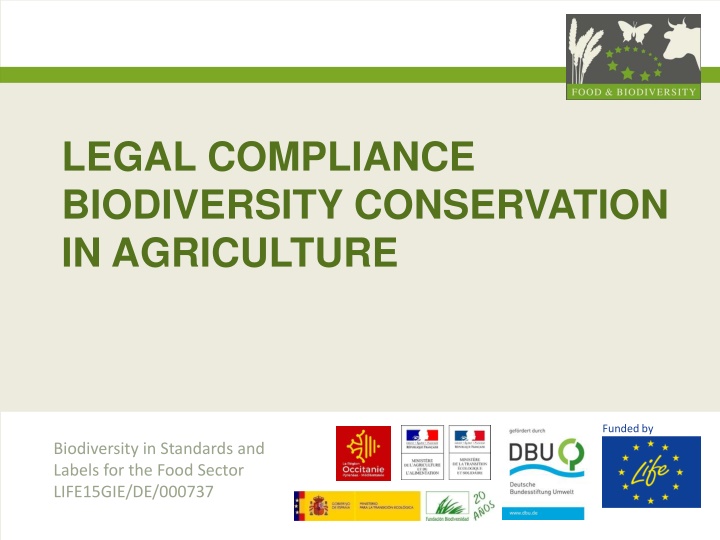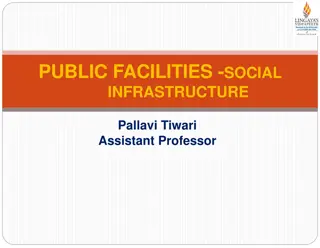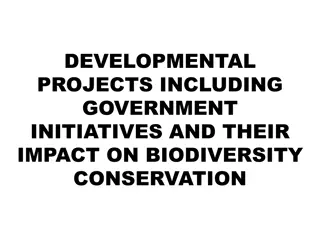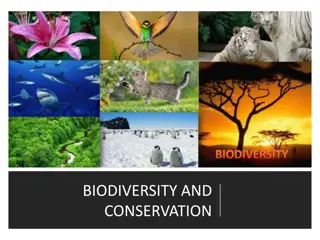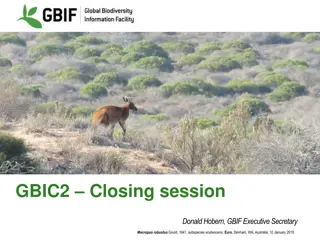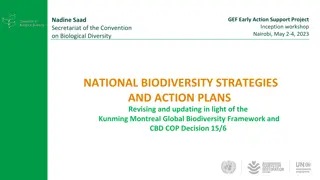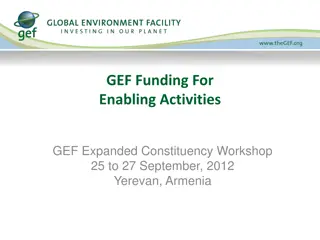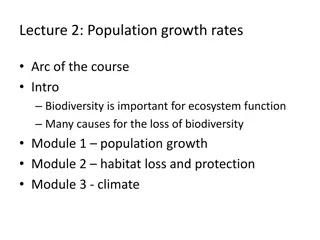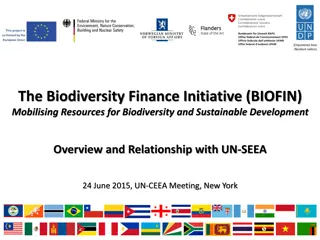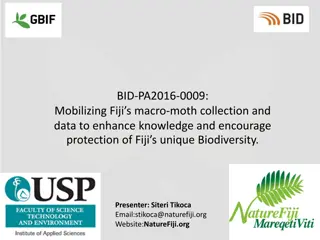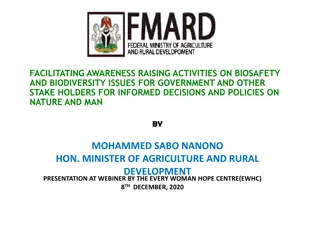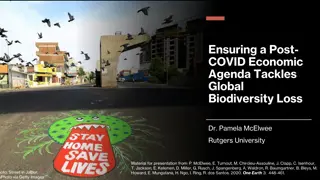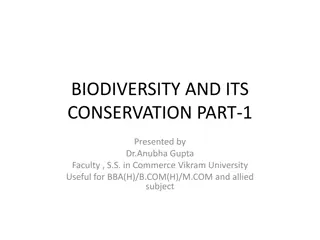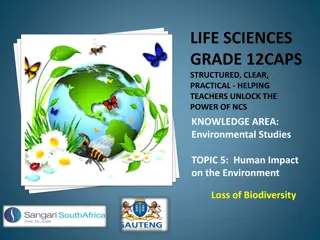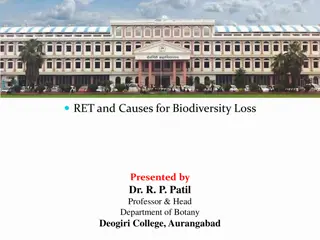Legal Compliance for Biodiversity Conservation in Agriculture
International conventions play a key role in setting norms and standards for biodiversity conservation in agriculture. The Convention on Biological Diversity, Rio Convention, Ramsar Convention, and others are vital agreements shaping policies around biodiversity. The focus is on conserving biological diversity, sustainable use of genetic resources, and fair benefit-sharing. Specific protocols like the Cartagena and Nagoya Protocols further enhance legal frameworks.
Download Presentation

Please find below an Image/Link to download the presentation.
The content on the website is provided AS IS for your information and personal use only. It may not be sold, licensed, or shared on other websites without obtaining consent from the author.If you encounter any issues during the download, it is possible that the publisher has removed the file from their server.
You are allowed to download the files provided on this website for personal or commercial use, subject to the condition that they are used lawfully. All files are the property of their respective owners.
The content on the website is provided AS IS for your information and personal use only. It may not be sold, licensed, or shared on other websites without obtaining consent from the author.
E N D
Presentation Transcript
LEGAL COMPLIANCE BIODIVERSITY CONSERVATION IN AGRICULTURE Funded by Biodiversity in Standards and Labels for the Food Sector LIFE15GIE/DE/000737
Introduction International Convention European Legislation National / Regional Legislation and Regulations Funded by Biodiversity in Standards and Labels for the Food Sector | LIFE15GIE/DE/000737 |
Legal compliance International Conventions are treaties or agreements between states. They originate International norms and standards Rights and obligations for countries which signed the Convention Policies and strategies of EU institutions and EU countries are treaties or agreements between states The most important conventions for biodiversity: Convention on Biological Diversity Rio Convention Convention on Wetlands Ramsar Convention Convention on the Conservation of Migratory Species of Wild Animals - Bonn Convention Convention on International Trade in Endangered Species of Wild Fauna and Flora (CITES) - Washington Convention Funded by Biodiversity in Standards and Labels for the Food Sector | LIFE15GIE/DE/000737 | 3
International Conventions Convention on Biological Diversity International legal agreement since 1992, Signed by most of the countries (196 parties) Three main goals: The conservation of biological diversity (or biodiversity) The sustainable use of the components of biological diversity The fair and equitable sharing of the benefits arising out of the utilization of genetic resources Include thematic work programms on Agriculture and biodiversity Objectives: It s objective is also to develop national strategies for the conservation and sustainable use of biological diversity systems and practices on biodiversity Conservation and sustainable use of genetic resources of actual and potential value for food and agriculture; Fair and equitable sharing of benefits arising out of the use of genetic resources Strengthening positive effects and mitigation of negative impacts of agricultural Supplementary agreements to the Convention: + Cartagena Protocol on Biosafety Legally binding: Nagoya Protocol on Access and Benefit-sharing (ABS) Funded by Biodiversity in Standards and Labels for the Food Sector | LIFE15GIE/DE/000737 | 4
International Conventions Convention on Wetlands (Ramsar Convention) Framework for national action and international cooperation for conservation and wise use of wetlands and their resources Largest network of protected areas: Over 2,200 Ramsar Sites on the territories of 169 Ramsar Contracting Parties across the world, covering more than 2.1 million square kilometres Contracting Parties commit to: Work towards the wise use of all their wetlands; Designate suitable wetlands for the list of Wetlands of International Importance (the Ramsar List ) and ensure their effective management; Cooperate internationally on transboundary wetlands, shared wetland systems and shared species. relating to wetlands, including suggestions on how these could be integrated into the Convention s policy and practice Agriculture & Food Heritage Thematic Group sustainable traditional wetland agricultural knowledge and practices, long-established sustainable water and wetland management systems and food cultures related to wetlands. development of lessons learned concerning cultural aspects of food and agriculture Funded by Biodiversity in Standards and Labels for the Food Sector | LIFE15GIE/DE/000737 | 5
International Conventions International Treaty on Plant Genetic Resources for Food and Agriculture Aim: Conservation and sustainable use of plant genetic resources for food and agriculture Recognizing the enormous contribution of farmers to the diversity of crops that feed the world International Plant Protection Convention Aims to protect world plant resources, including cultivated and wild plants by preventing the introduction and spread of plant pests and promoting the appropriate measures for their control Funded by Biodiversity in Standards and Labels for the Food Sector | LIFE15GIE/DE/000737 | 6
European Legislation 1. Conservation of Natural Habitats and of Wild Fauna and Flora (Habitats Directive) Sets up the EU Natura 2000 Network Annex I covers habitats, Annex II species requiring designation of Special Areas of Conservation Annex IV species in need of strict protection, and Annex V species whose taking from the wild can be restricted by European law. Once special areas for conservation are designated, EU countries must guarantee the conservation of habitats in these areas and avoid their deterioration and any significant disturbance to species European Legislation Habitat Directive 92/43/EEC Birds Directive 2004/35/CE See also Environmental Liability Funded by Biodiversity in Standards and Labels for the Food Sector | LIFE15GIE/DE/000737 | 7
Protection of Nature and Biodiversity Natura 2000 sites are not strictly protected areas in which all activities are systematically excluded: Agricultural land accounts for about 40 % of the total area of Natura 2000 Many of the habitats and species protected by the Habitats and Birds Directives are even dependent on or associated with agricultural practices In some areas it is necessary to find ways of reintroducing compatible farming systems or to adapt existing practices so that they can contribute to the conservation of the habitats and species of Community interest for which the site has been designated European Commission (2014): Farming for Natura 2000 Funded by Biodiversity in Standards and Labels for the Food Sector | LIFE15GIE/DE/000737 | 8
European Legislation 2. Conservation of Birds (Birds Directive) Covers the protection, management and control of all species of naturally occurring birds; lays down rules for their exploitation, applies to birds, their eggs, nests and habitats Measures include: EU countries must create special protection areas (SPAs) for threatened species and migratory birds; SPAs form part of the Natura 2000 network upkeep and management in accordance with the ecological needs of habitats inside and outside the protected zones; re-establishment of destroyed biotopes; creation of biotopes. European Legislation Habitat Directive 92/43/EEC Birds Directive 2004/35/CE See also Environmental Liability Funded by Biodiversity in Standards and Labels for the Food Sector | LIFE15GIE/DE/000737 | 9
European Directives National legislation EU Fauna-Flora-Habitat Directive German Federal Nature Conservation Act (Bundesnaturschutzgesetz) EU Birds Directive Regional Federal Nature Conservation Act (Landes naturschutzgesetz) German Legislation Federal Nature Conservation Act (BNatSchG) Building Code (BauGB) Funded by Biodiversity in Standards and Labels for the Food Sector | LIFE15GIE/DE/000737 | 10
European Water Framework Directive The aim is to obtain a good status of all waters. protecting all forms of water (surface*, ground*, inland* and transitional*); restoring the ecosystems in and around these bodies of water; reducing pollution in water bodies; guaranteeing sustainable water usage by individuals and businesses Environmental quality standards (EQS) concerning the presence in surface water of certain substances or groups of substances identified as priority pollutants on account of the risk they pose to or via the aquatic environment. European Legislation German Legislation Water Framework Directive (Directive 2000/60/EC) Water Resources Act (WHG) Environmental quality standards in the field of water policy (Directive 2008/105/EC) Waste Water Ordinance (AbwV) Protection of groundwater against pollution and deterioration (Directive 2006/118/EC ) Protection of waters against pollution caused by nitrates from agricultural sources (Council Directive 91/676/EEC) Good Professional Practice * Funded by Biodiversity in Standards and Labels for the Food Sector | LIFE15GIE/DE/000737 | 11
Environmental Liability Environmental damage is defined as: Damage that affects the environmental status of water resources, as defined in the EU Water Directive (and the Marine Environment Strategy Directive) Damage to protected species and natural habitats that adversely affects conservation as defined in the Birds Directive and Habitats Directive; Damage to land creating a significant risk to human health Companies who cause environmental damage, are liable for this and must take the necessary precautionary or remedial measures and bear all associated costs European Legislation German Legislation Environmental liability with regard to the prevention and remedying of environmental damage (Directive 2004/35/CE) Environmental Damage Act (USchadG) Funded by Biodiversity in Standards and Labels for the Food Sector | LIFE15GIE/DE/000737 | 12
Invasive alien species (IAS) Rules to prevent, minimise and mitigate the adverse impact on biodiversity of the introduction and spread of invasive alien species (IAS) Species may not be intentionally brought into the EU, nor may they be kept, bred, transported to, from or within the EU, sold, grown or released into the environment. Legal regulation which extends and intensifies the protection of species of the regulation (EG) No. 338/97 of 1984, by which CITES was put into force in all EC member states. BArtSchV manages the specially protected and strictly protected animal and plant species European Legislation German Legislation Protection of species of wild fauna and flora by regulating trade therein (Council Regulation (EC) No 338/97) Federal Species Protection Ordinance (BArtSchV) Federal Wildlife Protection Ordinance (BWildSchG) Prevention and management of the introduction and spread of invasive alien species (Regulation (EU) No 1143/2014 ) German Genetic Engineering Act (GenTG) Birds Directive (2004/35/CE) Genetically modified food and feed (Regulation 1829/2003) Funded by Biodiversity in Standards and Labels for the Food Sector | LIFE15GIE/DE/000737 | 13
Invasive alien species (IAS) IAS as one major cause of crop loss and present significant threats BUT expansion of agriculture as one of the most relevant disturbance factor for the spread of IAS Farmers should e.g. inspect their equipment do not grow invasive alien species report sightings of non-native species Early, R. et al. (2016): Global threats from invasive alien species in the twenty-first century and national response capacities Center for Invasive Species and Ecosystem Health: I am a Rancher or Farmer, Why should I care about invasive species? Funded by Biodiversity in Standards and Labels for the Food Sector | LIFE15GIE/DE/000737 | 14
Good professional/agricultural practice As good professional practice, German law refers to compliance with certain principles of animal welfare and environmental protection in agriculture, forestry and fisheries. It can be seen as a framework for action and represents a basic strategy. In EU legislation good agricultural practice (GAP) are specific methods, which create food that is safe and wholesome and refer to compliance with certain principles of animal welfare and environmental protection in agriculture, forestry and fisheries. There are several broadly accepted schemes that producers can adhere to. Reference in European Legislation Reference in German Legislation Water Framework Directive (Directive 2000/60/EC) Federal Nature Conservation Act Federal Soil Protection Act Plant Protection Act Funded by Biodiversity in Standards and Labels for the Food Sector | LIFE15GIE/DE/000737 | 15
Common Agricultural Policy (CAP) - currently under revision - Legal framework for agriculture in the European Union Regulates subsidies to farmers, the market protection of agricultural goods and the development of rural regions in Europe In 2013 the CAP was reformed to strengthen the competitiveness of the sector and to promote sustainable farming (Cross Compliance) 30 % of funds must be used for measures to protect environment and combat climate change (Green Payments) Diversifying cultures; Maintenance of permanent grassland 5 % of arable land should be used for "ecologically advantageous elements" European Legislation German Legislation Direct Payment (DirektZahlDurchfG) Direct payments to farmers (Regulation (EU) No 1307/2013 ) Agricultural Payment Obligations Act (AgrarZahlVerpflG) Support for rural development (Regulation (EU) No 1305/2013 ) Financing, management and monitoring of the common agricultural policy (Regulation (EU) No 1306/2013) Funded by Biodiversity in Standards and Labels for the Food Sector | LIFE15GIE/DE/000737 | 16
Protection of Plants Framework to achieve a sustainable use of pesticides by reducing the risks and impacts of pesticide use on human health and the environment Integrated Pest Management (IPM) = growth of a healthy crop with the least possible disruption to agroecosystems, promote natural pest control mechanisms, e.g. by crop rotation, use of adequate cultivation techniques resistant/tolerant cultivars, use of balanced fertilisation, liming and irrigation practices, protection of important beneficial organisms European Legislation German Legislation Plant Protection Act (PflSchG) Sustainable use of pesticides (Directive 2009/128/EC) Seed Marketing Act (SaatG) Protective measures against the introduction into the Community of organisms harmful to plants (Council Directive 2000/29/EC) Seed Ordinance (SaatV) Food and Feed Code (LFGB) Landraces and varieties which are naturally adapted to the local and regional conditions (Directive 2008/62/EC) Vegetable landraces and varieties which have been traditionally grown (Directive 2009/145/EC ) Funded by Biodiversity in Standards and Labels for the Food Sector | LIFE15GIE/DE/000737 | 17
Protection of Soil Sustainably safeguard or restore the functions of the soil Good Professional Practice * in the application of fertilizers, soil additives, growing substrates and plant aids on agricultural land EC Fertilizers =guarantees farmers that fertilizers contain a minimum nutrient content and do not harm human, animal or plant health or the environment Regulation covers only mineral fertilisers. Other fertilisers are governed by EU countries national legislation (> D MV) Regulations of the use of sewage sludge in agriculture in such a way as to prevent harmful effects on soil, vegetation, animals and man European Legislation German Legislation Fertilizer (Regulation (EC) No 2003/2003) Federal Soil Protection Act (BBodSchG) Sewage sludge Directive (Council Directive 86/278/EEC) Fertilizer Ordinance (D MV) Fertiliser Ordinance (D V) Sewage sludge regulation (AbfKl rV) Funded by Biodiversity in Standards and Labels for the Food Sector | LIFE15GIE/DE/000737 | 18
Strengths and weaknesses in regard to biodiversity Legislation /Regulation Strengths /Weakness Convention on Biological Diversity Objectives 2020 of the EU and of German Biodiversity Strategy will not be achieved Ramsar Convention /Wetlands Many management plans are not implemented International Treaty on Plant Genetic Resources for Food and Agriculture Limited list of crops actually covered, thirty-five varieties of crops and crop families are included but do not cover some agriculturally important crops (e.g. soy) International Plant Protection Convention Funded by Biodiversity in Standards and Labels for the Food Sector | LIFE15GIE/DE/000737 | 19
Strengths and weaknesses in regard to biodiversity Legislation /Regulation Strengths /Weakness EU Habitats-Directive /Natura2000 Well established network of protected areas // Many management plans not implemented yet, low habitat connectivity leading to islands of sustainability EU Water Framework Directive Improvement of quality of rivers in most of the member states // Many restoration measures are not implemented, deadline extensions and softening of objectives on contamination by nitrates EU Environmental Liability Directive the first EU legal instrument to establish the application of the "polluter pays" principle // Inconsistent and partly inadequate handling by Member States, no consideration of the term "ecosystems EU Regulation Invasive Alien Species Too short, numerous important species are not included Funded by Biodiversity in Standards and Labels for the Food Sector | LIFE15GIE/DE/000737 | 20
Strengths and weaknesses in regard to biodiversity Legislation /Regulation Strengths /Weakness EU Pesticides Directive EU Commission is accused of frequently approving pesticide active substances even though risk assessment documents are incomplete. Use in environmental sensitive areas should be prohibited. EU Fertilizer Regulation Mainly being used for conventional inorganic mineral fertilisers, no limits for contaminants identified, does not entirely reflect the current market situation EU Practises and Programs Strengths /Weakness Good Agricultural Practise Aim at applying available knowledge to address environmental, economic, and social sustainability dimensions // different meanings and used in different contexts, often not sufficiently concrete and too general EU Common Agricultural Policy 5% of ecological focus areas is not sufficient and quality of these structures is not properly defined. Greening measures not effective to stop loss of biodversity. Financial support for biodiversity measures are not sufficient and therefore not attractive. In general, financial support should be given to farmers which contribute to protection of public goods. Funded by Biodiversity in Standards and Labels for the Food Sector | LIFE15GIE/DE/000737 | 21
Legal compliance More information: European legislation Funded by Biodiversity in Standards and Labels for the Food Sector | LIFE15GIE/DE/000737 | 22
